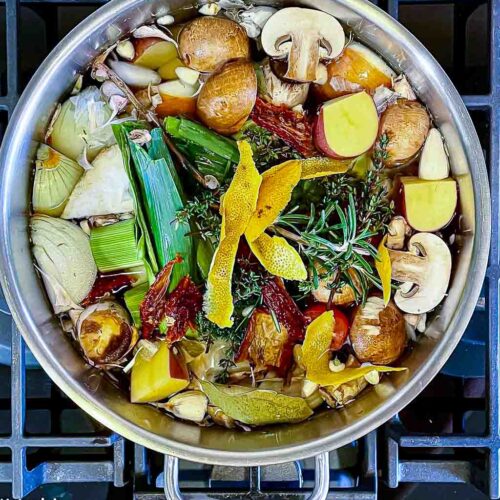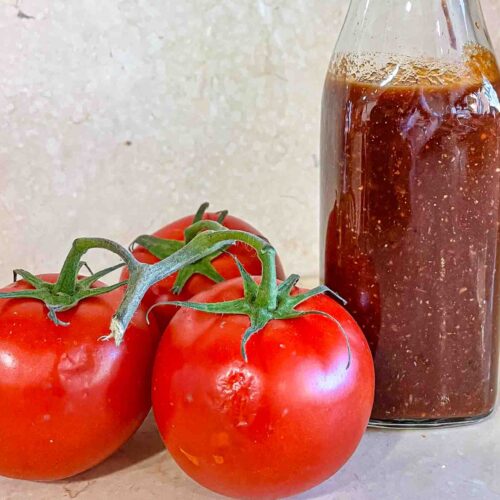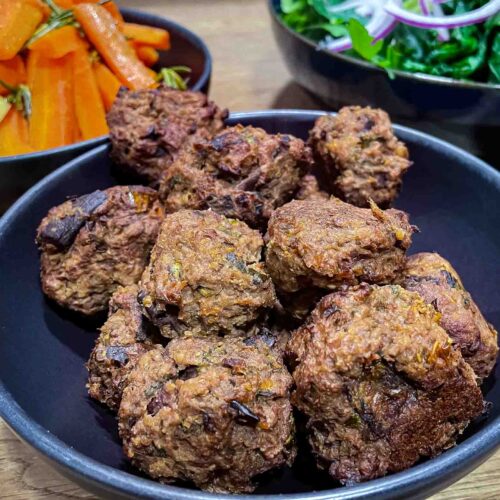Use Your Vegetable Scraps To Make Full Flavored Vegetable Stock.
Every day across the globe, a lot of vegetable scraps and trimmings left over after various meal preps get discarded. But all this “waste” can actually be turned into a perfectly flavorful homemade vegetable stock. Vegetable scraps such as carrot peels, celery tops and bottoms, onion cut-offs, squeezed lemons, mushroom stems and other such “waste” might not be edible per se, but they still contain a lot of flavor.
Instead of throwing all these lovely scraps out, save them in a large zip lock bag in the freezer, adding more scraps day by day, until you have a decent sized bag. Then use them, maybe together with some fresh stock ingredients and some added herbs, to make a lovely vegetable stock.
Why make your own vegetable stock?
Vegetable stocks are the foundation of many of my stews, soups, sauces and many other dishes such as Risotto. But most commercial stocks usually contain a large number of ingredients I generally try to avoid. First and foremost, commercially made stocks are very high in sodium. They also often contain a lot of sugar or other sweeteners. More often than not, they also contain a substantial amount of palm and/or coconut oil. These are usually listed simply as vegetable fat. Having lived in palm oil producing countries and seen the devastation those types of mono-culture plantations cause in the environment, I do my best to avoid products containing palm oil. As for coconut oil, that is something I only keep in my medicine cabinet – to speed up wound healing. If you are wondering why I take that stance on coconut oil you can check out my article Is Coconut Oil Healthy?
Every time I make stock I make a larger portion and keep whatever I don’t need that day in the fridge for a few days. The rest goes in the freezer, portion sized, until I need it. I also freeze some of my stock in ice cube trays. I sometimes use those little cubes instead of oil when sautéing.
Which scraps and trimmings are good to use.
The only types of vegetables I seriously do not recommend using in a stock are the ones belonging to the cruciferous family. So steer clear of broccoli, cauliflower, Brussels sprouts and all types of cabbage. Adding cruciferous vegetables to a stock results in a kind of “skunky” flavor. The asparagus is also a vegetable I generally don’t use in a stock due to its very distinct smell. But apart from that, knock yourself out!
The quick list of great stock scraps:
- Carrot peels
- Celeriac peels
- Celery tops and bottoms
- Mushroom stems
- Herb stems
- Lemons leftover after the juice has been squeezed out of them
- Garlic trimmings
- Onion trimmings (leave out most of the outer dry layer or your stock may become bitter)
- Leek trimmings
- Potato trimmings (I never use sweet potato scraps because they will make the stock too sweet for my liking)
- Jerusalem artichoke trimmings
- Ginger peels
- Lemongrass scraps
I have myself entered a natural rhythm where I now run out of stock right about the time my freezer bag gets full to the brim. But if you don’t have enough scraps in your freezer bag – or if they are generally from only a couple of different types of vegetables – then it’s perfectly fine to use whatever scraps you do have, together with fresh vegetables and additional herbs. Simply use your scraps together with the ingredients listed in the recipe below.
I generally have a lot of different types of scraps in my freezer bag so I rarely need to add fresh veggies when making stock. But I usually add extra flavors, like peppercorns and dried or fresh herbs. But it all depends on what goodies are in my freezer bag that day.
It’s up to you to decide what potential extras you want to add to your pot in order to get a well rounded and full-flavored stock.
The recipe below can be made with or without the use of scraps so even those of you who do not have space in your freezer for a goodie bag can make a beautiful homemade and healthy vegetable stock.

Homemade Vegetable Stock
Ingredients
- The contents of your freezer goodie bag
- 3 liters water
Depending on the content in your goodie bag you may want to add some or all of the following:
- 2 yellow onions quartered. Remove most of the dry skin
- 3 garlic cloves roughly chopped
- 3 carrots roughly chopped
- 2 celery stalks roughly chopped
- 2 tomatoes quartered
- 200 grams mushrooms roughly chopped
- 2 bay leaves
- 4 allspice berries
- A small handful fresh thyme or 1/2 teaspoon dried
- 2 large rosemary stems or 1/2 teaspoon dried
Optional ingredients that add extra flavor:
- Fennel
- Ginger
- Lemon peels
- Leeks
- Jerusalem artichoke
- Celeriac
- Sun-dried tomatoes
- Lemongrass
- Kaffir Lime leaves
- Peppercorns
- Other herbs, fresh or dry (oregano, basil, parsley, coriander, sage…)
- Spices (paprika, smoked paprika, coriander seeds, fenugreek seeds…)
Instructions
- Combine all the ingredients in a large pot and bring to a boil.
- Reduce the heat to a simmer, cover partially, and cook for about an hour. Strain, first through a fine meshed sieve and then through a cheesecloth, nut bag or a clean dish towel. This way you make sure there is absolutely no grit left in your stock.
- Store in the refrigerator for up to 3 days or in the freezer for up to 3 months.





